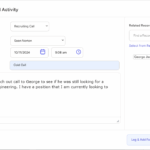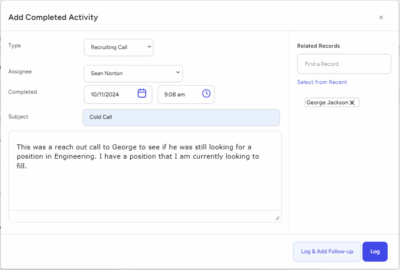In today’s fast-paced and often complex landscape business landscape, Human Resources professionals face a myriad of challenges, from managing a diverse and dynamic workforce to staying compliant with ever-changing regulations. As the backbone of every organization’s success, HR departments must navigate these complexities while also driving strategic initiatives to attract, develop, and retain top talent. Fortunately, advancements in technology have revolutionized HR practices, presenting a powerful solution: HR management software.
HR management software has transformative capabilities, as well as the potential to unlock efficiency and drive success in HR operations. Whether you are a small business or a large enterprise, the adoption of the right HR management software can be a game-changer in managing your human capital effectively.
What is HR management software?
But first things first . . . what is HR management software?
HR management software, also known as Human Resource Information System (HRIS) or Human Capital Management (HCM) software, is a sophisticated digital solution designed to revolutionize and streamline HR operations within an organization. It serves as a centralized platform that integrates various HR processes, facilitating efficient management of employee data, payroll, benefits, recruitment, performance evaluations, training, and more.
HR management software empowers HR professionals with tools to automate repetitive tasks, create personalized employee experiences, and make informed decisions through data-driven insights. With features like applicant tracking systems, performance management modules, and self-service portals, HR management software enhances productivity and fosters collaboration across the entire workforce lifecycle.
By eliminating manual paperwork and streamlining critical HR functions, this software saves time, reduces administrative burden, and enables HR teams to focus on strategic initiatives that drive employee engagement, development, and organizational growth. In addition, this software ensures compliance with labor laws and regulations, safeguarding the organization against potential legal risks.
Overall, HR management software plays a pivotal role in transforming HR practices, optimizing employee management, and contributing to the overall success and competitiveness of modern businesses.
HR management software features
Human Resources management is a critical function within any organization, responsible for overseeing the entire employee lifecycle and ensuring the workforce’s well-being and productivity. As businesses grow and the workforce becomes more diverse and dynamic, traditional HR processes struggle to keep up with the demands of the modern workplace.
HR management software has emerged as a comprehensive solution to streamline and optimize HR operations. Listed below are the extensive features of HR management software, designed to empower HR professionals with tools that enhance efficiency, improve employee experience, and facilitate data-driven decision-making.
#1—Employee data management
HR management software offers a centralized and secure platform for storing and managing employee data. This feature includes personal information, contact details, employment history, certifications, performance evaluations, and more.
The software ensures that HR professionals have instant access to essential employee records, facilitating efficient data retrieval and updating.
#2—Applicant tracking system (ATS)
The ATS feature within this software simplifies and accelerates the recruitment process. It allows organizations to post job openings, receive and screen applications, schedule interviews, and manage candidate communication.
ATS automates candidate tracking and shortlisting, saving HR professionals significant time and effort.
#3—Payroll and benefits administration
HR management software offers comprehensive payroll and benefits management capabilities. The software automates payroll processing, ensuring accurate and timely salary payments.
In addition, it streamlines benefits administration, including health insurance, retirement plans, and other employee perks, simplifying enrollment and tracking.
#4—Performance Management
The performance management feature within HR management software facilitates setting performance goals, conducting evaluations, and providing feedback.
HR professionals can track employee progress, identify skill gaps, and support employee development.
#5—Training and development
HR management software assists in organizing and managing employee training programs.
It tracks attendance, evaluates the effectiveness of training initiatives, and supports individual and organizational development efforts.
#6—Time and attendance tracking
Automating time and attendance tracking is an essential feature of this software.
It reduces manual errors, ensures accurate time calculations for payroll purposes, and streamlines employee attendance records.
#7—Employee self-service portals
HR management software often includes self-service portals, allowing employees to access and update their personal information, view pay stubs, request time off, and manage benefits independently.
This feature empowers employees and reduces HR administrative tasks.
#8—Reporting and analytics
HR management software generates comprehensive reports and analytics on various HR metrics.
These insights offer valuable information on workforce trends, employee engagement, turnover rates, and other key performance indicators (KPIs).
#9—Compliance and regulatory support
HR management software helps organizations stay compliant with labor laws and industry regulations.
The software includes features that automate compliance-related tasks and ensure adherence to legal requirements.
HR management software offers a comprehensive set of features that transform HR operations, driving efficiency and effectiveness in managing the workforce. By leveraging the features of this software, organizations can streamline administrative tasks, enhance employee engagement, and make data-driven decisions that positively impact the organization’s overall performance. As businesses continue to embrace digital transformation, HR management software will remain a crucial asset for navigating the complexities of the modern workforce and driving organizational success.
HR management software: advantages and benefits
As we’ve discussed, HR management software is a powerful and comprehensive solution designed to streamline HR operations, enhance efficiency, and empower HR professionals with data-driven decision-making capabilities. We’ve also addressed the many features of this software. However, what about the advantages and benefits? We’re so glad that you asked!
Listed below are the numerous advantages and benefits of HR management software, demonstrating its potential to revolutionize HR practices and drive success across different areas of an organization.
#1—Streamlining HR operations
One of the primary advantages is its ability to streamline HR operations. By automating manual and time-consuming administrative tasks, HR professionals can allocate more time and resources to strategic initiatives that add value to the organization.
Processes such as employee data management, payroll processing, benefits administration, and applicant tracking are efficiently handled by the software, reducing errors and improving overall efficiency.
#2—Improved data accuracy and security
HR management software ensures that employee data is accurately captured, updated, and securely stored in a centralized system. This reduces the risk of data duplication, manual errors, and data loss, resulting in improved data integrity.
With role-based access controls and data encryption, the software enhances data security, safeguarding sensitive employee information from unauthorized access or breaches.
#3—Enhanced recruitment and talent acquisition
The applicant tracking system (ATS) feature within HR management software optimizes the recruitment process. ATS automates candidate sourcing, screening, and shortlisting, enabling HR professionals to identify top talent quickly.
This streamlined approach improves time-to-fill positions and enhances the organization’s ability to attract and retain qualified candidates.
#4—Efficient payroll and benefits management
HR management software streamlines payroll processing, ensuring timely and accurate salary payments. Additionally, it simplifies benefits administration, including health insurance, retirement plans, and other employee perks.
This efficient management of payroll and benefits reduces administrative burden, enhances employee satisfaction, and minimizes the risk of errors in compensation and benefits.
#5—Performance management and employee development
With performance management features, HR management software facilitates goal setting, performance evaluations, and feedback sessions. HR professionals can track employee progress, identify skill gaps, and design personalized development plans.
This fosters a culture of continuous learning and growth, resulting in improved employee performance and job satisfaction.
#6—Training and learning initiatives
HR management software aids in organizing and managing employee training programs. It tracks attendance, evaluates training effectiveness, and measures its impact on individual and organizational performance.
This feature enhances employee skills and competencies, contributing to the organization’s overall productivity and competitiveness.
#7—Accurate time and attendance tracking
The software’s time and attendance tracking feature automates the recording and calculation of employee working hours.
This ensures precise timekeeping for payroll calculations, minimizes time theft, and simplifies absence management and time-off requests.
#8—Employee self-service portals
HR management software often includes employee self-service portals, empowering employees to access and update their personal information, view pay stubs, request time off, and manage benefits independently.
This feature enhances employee engagement, reduces HR administrative tasks, and allows employees greater control over their own data.
#9—Data-driven decision making
HR management software generates comprehensive reports and analytics on various HR metrics, providing valuable insights into workforce trends, employee engagement, turnover rates, and other key performance indicators (KPIs).
These data-driven insights enable HR professionals and organizational leaders to make informed decisions and devise effective HR strategies.
#10—Compliance and regulatory support
HR management software includes features that help organizations stay compliant with labor laws and industry regulations.
The software automates compliance-related tasks, such as tracking mandatory training, managing certifications, and ensuring adherence to data protection regulations.
#11—Enhanced employee experience and engagement
By streamlining HR processes and providing self-service capabilities, HR management software enhances the overall employee experience.
Employees can access information and perform tasks conveniently, leading to higher satisfaction and engagement levels.
#12—Scalability and flexibility
HR management software is designed to accommodate organizations of all sizes and adapt to their unique needs.
As businesses grow or face changes in HR requirements, the software can scale and evolve accordingly.
The advantages and benefits of HR management software are numerous and profound, revolutionizing the way HR departments operate and interact with employees. From efficient payroll and benefits management to data-driven decision-making and compliance support, HR management software optimizes HR practices and fosters a positive employee experience. As businesses continue to embrace digital transformation, HR management software will remain a crucial asset for navigating the complexities of the modern workforce and driving organizational growth and prosperity.
HR management software: trends and challenges
As you can see, HR management software provides tremendous amounts of value. It provides this value through its many features, as well as the advantages and benefits tied to those features. However, as one might assume, there are multiple trends associated with this type of software. And it has its fair number of challenges, too.
In this section, we will explore the emerging trends in HR management software and the challenges it faces, shedding light on how organizations can navigate the future of work successfully.
Trends in HR management software
Let’s start with the prevailing and emerging trends. Below are six trends associated with HR management software and how it affects the organizations that use it:
#1—AI and automation integration
One of the most significant trends is the integration of Artificial Intelligence (AI) and automation. AI-powered algorithms enable the software to automate repetitive tasks, such as candidate screening, resume parsing, and personalized employee training recommendations.
Automation streamlines processes, reduces human errors, and empowers HR professionals to focus on strategic initiatives that drive employee engagement and organizational growth.
#2—Employee experience enhancement
As organizations prioritize employee well-being and experience, HR management software is evolving to cater to these needs. User-friendly interfaces, mobile applications, and self-service portals empower employees to access and update their information, request time off, and engage in personalized learning and development opportunities.
By providing a seamless employee experience, the software fosters higher job satisfaction and stronger employee-employer relationships.
#3—Talent analytics and predictive insights
Advanced analytics and data visualization capabilities have become integral features of modern HR management software. The software generates valuable insights through talent analytics, identifying workforce trends, predicting potential retention issues, and recommending workforce optimization strategies.
These predictive insights enable HR professionals and organizational leaders to make informed decisions, aligning HR practices with business goals.
#4—Cloud-based solutions
The adoption of cloud-based HR management software has been on the rise due to its scalability, flexibility, and cost-effectiveness. Cloud-based solutions allow seamless access to HR data from anywhere, enabling remote work and accommodating the needs of a distributed workforce.
These solutions also reduce the burden of maintaining on-premises infrastructure, leading to significant cost savings.
#5—Mobile compatibility
The proliferation of mobile devices has influenced HR management software development.
Mobile compatibility ensures that employees and HR professionals can access the software’s features and functionalities on their smartphones and tablets, facilitating real-time communication and decision-making.
#6—Inclusive HR practices
HR management software is increasingly incorporating features to promote diversity, equity, and inclusion in the workplace. This includes blind resume screening to reduce unconscious bias in candidate selection and gender-neutral language in job postings to attract a diverse pool of applicants. The software helps organizations create a more inclusive and diverse workforce.
Challenges in HR management software
Despite the value that it provides, everything is not “sunshine and rainbows” when it comes to this software. That’s because it also has its share of challenges, all of which organizations must overcome if they want to maximize the potential and realize the full value of the software.
With that in mind, below are seven challenges associated with HR management software:
#1—Data security and privacy concerns
As HR management software deals with sensitive employee information, data security and privacy are paramount concerns.
Organizations must ensure that the software adheres to robust data protection measures, complies with relevant regulations, and prevents unauthorized access to employee data.
#2—Integration with existing systems
Integrating HR management software with other existing systems, such as payroll and accounting software, can be a complex process.
Seamless integration is essential to ensure data consistency, eliminate information silos, and facilitate cross-functional decision-making.
#3—User adoption and training
The successful implementation of this software depends on user adoption and adequate training. HR professionals and employees need to be proficient in using the software’s features to maximize its benefits fully.
Providing comprehensive training and ongoing support is crucial to overcoming any resistance to change.
#4—Cost considerations
While HR management software offers numerous benefits, the initial investment and ongoing costs associated with software implementation and maintenance should be carefully evaluated.
Organizations must weigh the benefits against the expenses to make informed decisions.
#5—Customization and scalability
As organizations have unique HR needs, HR management software should offer customization options to cater to specific requirements.
Scalability is also essential to accommodate the organization’s growth and changing workforce dynamics.
#6—Data quality and accuracy
HR management software’s effectiveness relies heavily on the accuracy and quality of the data it processes. Incomplete or erroneous data can lead to flawed analytics and inaccurate decision-making.
Maintaining data integrity requires diligent data validation and regular data cleansing processes.
$7—Ensuring inclusivity and unbiased algorithms
While AI and automation enhance HR management software capabilities, it is crucial to ensure that the algorithms used in the software are unbiased and inclusive.
Bias in AI algorithms can perpetuate existing inequalities in hiring and employee development processes.
HR management software is at the forefront of driving efficiency, employee experience enhancement, and data-driven decision-making in HR practices. As organizations embrace the latest trends in AI and automation integration, employee experience enhancement, talent analytics, and cloud-based solutions, they can harness the full potential of this software to stay competitive in the ever-evolving business landscape.
However, HR management software also faces challenges, such as data security concerns, integration complexities, user adoption, and customization needs. By addressing these challenges head-on, organizations can create a robust HR infrastructure that empowers HR professionals, enhances the employee experience, and fosters a positive and inclusive workplace culture. As the future of work continues to evolve, HR management software will remain a crucial tool in navigating the complexities of the modern workforce and driving organizational success.
HR management software: use cases
As we have seen, with its comprehensive features and capabilities, HR management software streamlines various HR processes, enhances employee experience, and empowers HR professionals with data-driven insights. To fully illustrate the power and potential of this software, though, perhaps examining some cases studies is in order.
Below is a list of 12 diverse use cases of HR management software, showcasing its versatility and impact on organizations of all sizes and industries:
#1—Efficient recruitment and talent acquisition
One of the primary use cases of HR management software is streamlining the recruitment and talent acquisition process. The software’s Applicant Tracking System (ATS) feature automates candidate sourcing, resume screening, and interview scheduling.
This enhances the efficiency of talent acquisition, allowing HR professionals to identify and hire the most qualified candidates quickly. In addition, this software facilitates a positive candidate experience by providing timely communication and personalized interactions throughout the hiring journey.
#2—Seamless onboarding and employee integration
HR management software simplifies the onboarding process for new hires, ensuring a seamless integration into the organization. The software allows HR professionals to create personalized onboarding plans, deliver essential training materials, and provide access to company policies and resources.
By facilitating a smooth onboarding experience, the software enhances employee satisfaction and retention rates.
#3—Performance management and talent development
This software aids in performance management by providing tools to set performance goals, conduct evaluations, and track employee progress. The software supports regular feedback sessions and helps identify skill gaps, enabling HR professionals to design personalized development plans.
This use case fosters a culture of continuous learning and growth, enhancing employee performance and engagement.
#4—Payroll processing and benefits administration
HR management software automates payroll processing, ensuring accurate and timely salary payments. It also streamlines benefits administration, making it easier for HR professionals to manage health insurance, retirement plans, and other employee perks.
By minimizing administrative burden and reducing the risk of errors in compensation and benefits, the software improves overall workforce satisfaction.
#5—Training and learning initiatives
This software assists in organizing and managing employee training programs. The software tracks attendance, evaluates training effectiveness, and measures its impact on individual and organizational performance.
This use case enhances employee skills and competencies, leading to improved productivity and increased organizational competitiveness.
#6—Time and attendance tracking
Automating time and attendance tracking is a crucial use case of HR management software. The software accurately records employee working hours, reducing manual errors and ensuring precise timekeeping for payroll calculations.
In addition, the software simplifies absence management and time-off requests, contributing to better workforce planning.
#7—Employee self-service portals
This software often includes employee self-service portals, empowering employees to access and update their personal information, view pay stubs, request time off, and manage benefits independently.
This use case enhances employee engagement, reduces HR administrative tasks, and allows employees greater control over their own data.
#8—Talent analytics and predictive insights
Advanced talent analytics is a powerful use case of HR management software. By generating valuable insights, the software identifies workforce trends, predicts potential retention issues, and recommends strategies for workforce optimization.
These predictive insights enable HR professionals to make informed decisions aligned with organizational objectives.
#9—Compliance and regulatory support
HR management software includes features that help organizations stay compliant with labor laws and industry regulations. The software automates compliance-related tasks, such as tracking mandatory training, managing certifications, and ensuring adherence to data protection regulations.
This use case reduces the risk of non-compliance and legal penalties.
#10—Strategic workforce planning
This software contributes to strategic workforce planning by providing HR professionals and organizational leaders with access to real-time data and analytics.
This use case enables organizations to anticipate talent needs, identify skill gaps, and develop succession plans to secure a strong talent pipeline.
#11—Remote workforce management
With the rise of remote and distributed teams, HR management software has become essential in managing a dispersed workforce.
The software enables HR professionals to effectively communicate with remote employees, track their performance, and facilitate virtual collaboration.
#12—Diversity, equity, and inclusion (DE&I) initiatives
HR management software can support DE&I initiatives by incorporating features that promote diversity and reduce bias in the hiring process.
Blind resume screening, gender-neutral language in job postings, and other inclusive features help organizations create a more diverse and inclusive workforce.
HR management software offers a diverse range of use cases that cater to the multifaceted needs of HR professionals and organizations. As organizations continue to embrace digital transformation, HR management software remains at the forefront of shaping a positive employee experience, fostering a culture of continuous learning, and optimizing workforce management.
By harnessing the versatility and potential of HR management software, organizations can stay competitive, nurture their most valuable asset—their employees—and navigate the complexities of the modern workforce successfully!
How to select HR management software
We’re almost done! We know just about everything we need to know about HR management software. The only thing left is to know how to select the right solution for your organization.
However, with a plethora of options available in the market, selecting the right software solution can be a daunting task. The guide below aims to walk you through the essential steps involved in choosing the perfect HR management software that aligns with your organization’s needs and objectives.
Those 10 steps are as follows:
Step #1—Assess your organization’s requirements.
The first and most critical step in selecting HR management software is to identify and understand your organization’s specific needs and requirements.
Involve key stakeholders, HR professionals, and department heads to gather comprehensive insights into the current HR processes, pain points, and areas that need improvement. Create a detailed list of functionalities and features necessary to streamline HR operations and boost efficiency.
Step #2—Set a realistic budget.
Having a well-defined budget is crucial before embarking on the selection process. HR management software can vary significantly in cost, from affordable cloud-based solutions to comprehensive enterprise-level platforms.
Consider both the initial investment and the ongoing costs for licensing, maintenance, and support. Aim for a balance between your budget constraints and the essential features required for your organization.
Step #3—Research available HR management software.
Now that you have a clear understanding of your organization’s requirements and budget, start researching the available software options in the market.
Read online reviews, case studies, and customer testimonials to gain insights into the user experience and overall satisfaction levels. Shortlist the software solutions that align with your organization’s needs and budget constraints.
Step #4—Evaluate user-friendliness and interface
A user-friendly interface is vital for successful software adoption across the organization.
Request demos or trial versions of the shortlisted HR management software and involve the end-users (HR team members) in the evaluation process. Pay attention to the ease of navigation, accessibility, and intuitiveness of the software.
Step #5—Consider scalability and integration.
As your organization grows, so will your HR needs. Therefore, it’s essential to select a software solution that is scalable and can accommodate your future requirements.
In addition, ensure that the software integrates seamlessly with your existing HR tools, such as payroll systems, performance management software, and applicant tracking systems, to avoid data silos and manual data entry.
Step #6—Analyze security and compliance.
Given the sensitive nature of HR data, security and compliance are of paramount importance.
Evaluate the data security measures implemented by the software vendor, including encryption, access controls, and data backup protocols. Ensure that the software complies with relevant data protection regulations, such as GDPR, HIPAA, or CCPA, depending on your location and industry.
Step #7—Seek customization and support options
Each organization has unique HR processes and workflows, so it’s crucial to choose HR management software that can be tailored to meet your specific needs. Inquire about the customization options offered by the vendors.
In addition, assess the support and training resources available, as well as the responsiveness of the vendor’s customer support team.
Step #8—Compare pricing and licensing models
Obtain detailed pricing information from the shortlisted vendors. Some vendors offer a one-time license fee, while others provide subscription-based models.
Analyze the long-term costs associated with each option and consider the value each vendor brings to the table in terms of features, support, and future updates.
Step #1—Check vendor reputation and reliability.
Investigate the reputation and reliability of the HR management software vendors on your shortlist.
Look for established vendors with a proven track record of serving organizations similar to yours. Check for any past incidents of data breaches or major software outages to gauge the vendor’s overall reliability.
Step #1—Seek feedback from existing users
Reach out to existing customers of the software you are considering. Ask about their experience with the software, its strengths, weaknesses, and how well it has addressed their HR needs.
User feedback can provide valuable insights that may not be apparent from the vendor’s marketing materials.
Selecting the right HR management software is a critical decision that can significantly impact your organization’s HR processes and overall efficiency. By following the 10 steps listed above—from assessing your requirements to seeking feedback from existing users—you can make a well-informed choice that aligns with your organization’s needs and goals.
Remember that the process of selecting HR management software is not just a one-time event but a crucial investment in the future success of your HR department and your entire organization!








